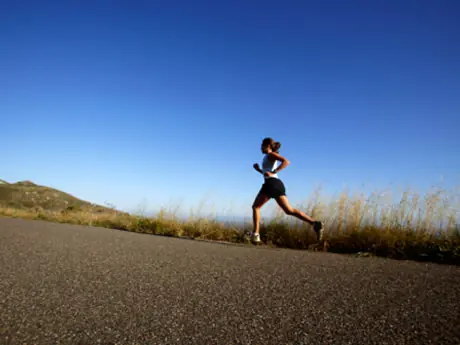Your Body During The Ultramarathon Race
After running marathon distances in training, your body is prepared to handle the first 15 miles of an ultra. It isn't until the 18- to 20-mile mark that your body begins to feel a variety of sensations, most specifically: "muscle damage, hormonal changes and sleep deprivation," says Hart. Here's a breakdown of what happens to the body during an ultramarathon:
- Cramping Starts: Many runners get by with mediocre nutrition, says Robert Mitchell, owner of RunJunk.com. However, he explains that it can be important for ultrarunners: "to be in tune with electrolytes and not be overloading on sugar." Around mile 18, there's a lot of cramping due to electrolyte loss, he explains, so you need to be aware of what your body needs to overcome nutrition deficiencies and refuel.
- Cortisol Levels Rise: At such long distances, this is inevitable. "You're putting a large amount of stress on your body while trying to run hours and hours at a time, and usually on difficult terrain," says Gill. As cortisol levels rise, your body turns to its current storage of fat and protein to avoid fatigue and muscle pain.
More: 4 Tips to Fuel for an Ultra-Distance Race
- Sleep Deprivation Sets In: Ultra competitors run and walk for more than 24 hours at a time, and sleep deprivation is a natural bodily function that sets in as the sun goes down. You may experience dizziness, disorientation and, in some extreme cases, hallucinations.
- Hypothermia Takes Effect (sometimes): Running at high elevations, in rain, high winds or snow for many hours can cause hypothermia. But even on days with good weather, this is a concern: "This is important for the ultramarathon runner because late in the race, a decrease in ambient temperature of only a few degrees can precipitate symptoms of hypothermia," says Eric Holden, PA-C, MPA, EMT-P.
- Hyperthermia Makes an Appearance (sometimes): When your body is so hot that it can no longer remove heat, it goes into a state of hyperthermia. While this doesn't happen to everyone during an ultra, it isn't uncommon, especially in warm weather. However, even in cold temperatures, ultrarunners may experience this thanks to extreme changes in temperature from night to day, and as they climb and descend high elevations.
- Blisters Develop: While not every ultrarunner develops blisters during the race, many do thanks to sweat or water from the trail. Some participants tape their feet to avoid any issues with blisters, as well as broken toenails.
Another mid-race commonality: changing clothes. Depending on the weather, the course, and sweat levels, some ultrarunners will change two to three times during the race. "The need to change will be determined by the weather conditions and the course conditions. I've had to run through a creek a couple of times in one race so I needed to bring at least two pairs of dry socks," says Gill.
- 2
- of
- 3
About the Author

Get ACTIVE on the Go


Couch to 5K®
The best way to get new runners off the couch and across the finish line of their first 5K.
Available for iOS | Android







Discuss This Article